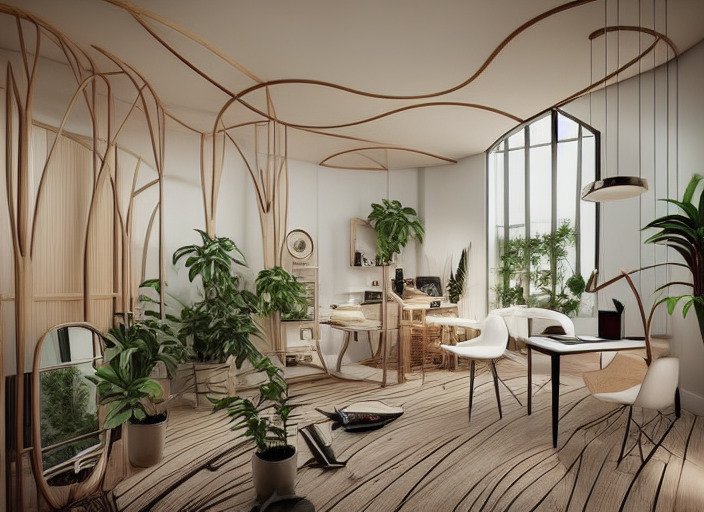AI vs. Human Interior Design
The allure and limitations of AI Interior Design
In recent years, technology has assumed a pivotal role in the field of design, revolutionizing the way we conceptualize and bring spaces to life. The marriage of creativity with cutting-edge tools has opened new frontiers, enabling designers to push boundaries and explore uncharted territories. Yet, amidst this technological boom, a fundamental question persists: can artificial intelligence truly replace the nuanced touch of human design? This debate lies at the heart of our exploration.
The Evolution of Design: From Pen and Paper to Algorithms
At its core, design is a discipline steeped in history. From the hand-drawn blueprints of old to the advent of computer-aided design (CAD), the evolution of design tools is a testament to human ingenuity. With the rise of artificial intelligence, we witness a paradigm shift. Algorithms, once confined to the realm of data, now find a place in the creative process. This transformation brings with it a surge of possibilities, yet raises concerns about the potential loss of human intuition in design
The Allure of AI in Design
Image: Arch Daily
The allure of AI in design lies in its unparalleled capacity for efficiency and speed. AI-powered tools can swiftly generate an array of design options, presenting designers and clients with a breadth of choices in record time. Moreover, the ability to customize and personalize designs to a granular level is a hallmark of AI's prowess. Spaces can be tailored with a precision that surpasses what was previously imaginable, allowing for a level of individualization that resonates deeply with occupants.
The Limitations of AI in Design
However, even with all its computational might, AI encounters a fundamental stumbling block: the intricacies of human preferences. Design, at its essence, is an art form that intertwines aesthetics with emotion. Understanding the idiosyncrasies of human taste, the subtle cues that resonate on an emotional level is a realm where AI struggles to measure up. The intangible magic that turns a space into a sanctuary often lies in these subtleties, a realm where human designers excel.
The Human Touch: Why it Matters
Herein lies the profound significance of the human touch in design. Spaces are not just physical constructs; they are living, breathing environments that shape the experiences of those who inhabit them. The psychology of spaces, the interplay of light, texture, and form, holds sway over our emotions and well-being. This innate understanding, honed by years of human experience, is an irreplaceable asset in the designer's toolkit. It allows for spaces that not only appeal visually but also resonate on a deeply human level, fostering a sense of belonging and comfort.
In the realm of interior design, the client-designer relationship is akin to the heartbeat of a project. It's a collaborative journey where trust and understanding form the bedrock of every decision. A human-centered approach means more than just aesthetics; it's about crafting spaces that reflect the unique tapestry of individual needs, tastes, and lifestyles. It's about creating environments that breathe and evolve with the people who inhabit them, aligning seamlessly with their routines and aspirations.
Balancing Act: AI as a Tool, Not a Replacement
The emergence of AI in design need not signal the obsolescence of human designers. Instead, it presents a harmonious partnership, a convergence of human intuition with computational precision. Designers today skillfully integrate AI as a supplementary tool, leveraging its strengths in generating options and refining details. This strategic dance allows for an efficient design process without compromising the innate human touch, preserving the emotional resonance that makes spaces come alive.
As we peer into the future, a symbiotic relationship between AI and human designers emerges on the horizon. Envision a landscape where algorithms enhance creativity, where human ingenuity infuses technology with soul. The potential for groundbreaking innovation is boundless, as these two forces collaborate to push the boundaries of what's achievable in design. Anticipating advancements in materials, techniques, and methodologies, we stand on the cusp of an exciting era where the fusion of AI and human insight will redefine what's possible.
Celebrating the Human Element in Design
In the grand tapestry of design, the human element remains the enduring thread. It's the heartbeat that infuses life into spaces, turning them from structures into sanctuaries. The narratives woven by designers and clients together are tales of collaboration, trust, and transformation. As we navigate the evolving landscape of design, let us hold fast to the understanding that the human connection is irreplaceable. It's what makes a space not just beautiful, but deeply resonant and alive.
At Astral House Interior Design, we're not only fascinated by the potential of AI in shaping spaces, but we're also committed to upholding the invaluable touch of human connection in every design. From St. Pete, Florida to the heart of Tampa Bay, and even reaching the vibrant neighborhoods of Raleigh, NC, our process is a testament to the power of a client-designer relationship. Our human-centered approach ensures that every space we craft is a reflection of your unique needs and lifestyle. Discover more about our mindful and innovative design process and how we blend cutting-edge technology with a genuine understanding of your vision.



